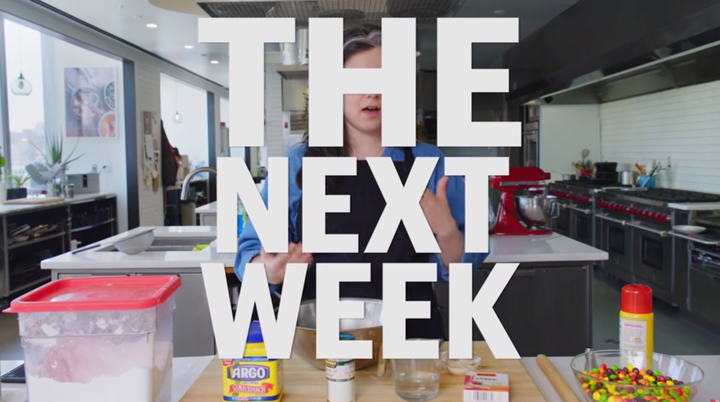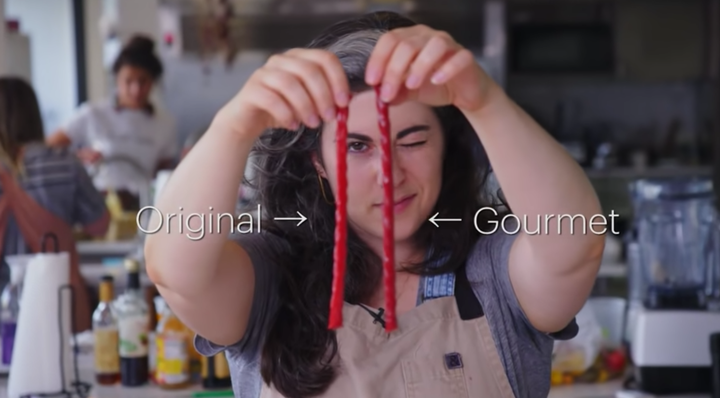It’s the last half of a cooking battle, and professional pastry chef Claire Saffitz is in a war against a Dorito. For three days, she’s dehydrated bell peppers to make cheese powder, diagramed the proper isosceles triangle for cutting out chips and calculated the correct masa harina dough. The end of her long journey is in sight, but then disaster strikes. During test 28, she toasts the Doritos chips too long in the oven after frying them. “I checked on them one minute ago and they were fine,” Saffitz said. “I’m not remaking them.” But when she tastes them, the flavor of the too-toasted chip overpowers the powdered cheese mix. Sad piano music plays as Saffitz resigns herself to her fate: She needs to start over and remake the chips tomorrow.
This is the drama of the popular Bon Appétit video series “Gourmet Makes.” Whenever a new episode pops up in my YouTube feed, I first look at the runtime. My excitement over each show is directly correlated to how long we get to watch Saffitz attempt a homemade version of the commercial snack foods of our youth with little to go on but a food wrapper and memories. Recent challenges include Starburst (40 minutes), Twix (39 minutes) and those pesky Doritos (46 minutes).
“Gourmet Makes” stands out for showing how a recipe is actually tested in a professional kitchen through trial and error. Saffitz is a professional chef figuring out how to engineer a recipe in real time during the show, and we’re privy to her failures and frustrations along the way. It’s the exact opposite of the impersonal approach of cooking videos on social media that feature just a pair of hands and a hot plate making a recipe in under a minute. As Saffitz endures days and days of attempting to recreate a favorite junk food, she is endearingly honest and extremely human: sighing, questioning her methods and eagerly anticipating the final product.
She makes problem-solving fun. And based on the thousands of people creating and sharing memes from the series, I’m not alone in finding the ups and downs of her challenges relatable to my own life.
Saffitz’s bold attempts at recreating processed snacks also model what leadership and management professor Amy Edmondson called “intelligent failure” in the Harvard Business Review. These are opportunities “when experimentation is necessary: When answers are not knowable in advance because this exact situation hasn’t been encountered before and perhaps never will be again,” Edmondson wrote. In other words, they’re the kind of productive failures you grow from.
Saffitz spoke with HuffPost about how the show has changed her perfectionist tendencies and her approach to cooking, and what we can apply about learning from failure to the kitchen or our careers.
The stuff Martha Stewart doesn’t show is where the magic happens
The basic formula of the show, which launched in 2017, follows the scientific method of making informed hypotheses and then testing them. We see Saffitz first break down the ingredients on a particular snack’s label, we watch as she researches what has been written about how it’s made, and then we follow as she starts to experiment with the best method for replicating the snack at home.
Sometimes chocolate doesn’t temper or Doritos come out too toasted — it’s not always a smooth process in which Saffitz gets it right on the first try or second day.
“Much to my dismay, and the pleasure of my director and everyone else, there is usually a series of unforeseen challenges,” Saffitz said.
On other cooking shows, those unforeseen challenges are typically edited out. Saffitz said she grew up watching cooking shows with people like Emeril Lagasse and Martha Stewart in which “there was an expert behind the camera who was demonstrating a recipe that they had mastered and it came out perfectly, and it was very aspirational and that was the whole show.”
“It was surprising to me and also a little bit confusing with ‘Gourmet Makes.’ Why does anyone wanna watch this?” Saffitz said. “It made me a little bit cautious about it because I felt like I didn’t look like an expert, that I was attempting these sort of difficult tasks and I didn’t really know what I was doing and it might not work.”
After hearing feedback on the show, though, she said she now loves that she gets to bring viewers into what the testing process is like.
“‘Gourmet Makes’ has absolutely made me, a natural perfectionist, much more comfortable with failure. I think I grew up as a high-achieving person in a family where that was important and I looked at failure very, very negatively,” she said. “I have absolutely learned that you learn so much more from the failures than the successes.”
Claire’s personal favorite makes
A common anxiety around cooking failure is the sunken cost, Saffitz said: “If it’s not going to turn out, then you’ve wasted time, money and energy.” And a fear of failure is common in general. One survey found more of us are scared of failure than of ghosts or being home alone. But getting comfortable with the idea that you may not get it all right is necessary to grow. Embracing what you’ve ended up with — mistakes and all — is valuable.
“The final result is not always terribly satisfactory,” Saffitz said about her “Gourmet Makes” attempts, though she said that her homemade Oreos were among the most satisfying and “a lot of fun.” She was also “deeply impressed” by the powder coating of her Doritos, noting that she was taken aback by how close her Doritos flavors were to the original. “I thought it really cracked some code,” she said.
The life lessons behind a bad attempt at Starburst
When asked which snacks were her biggest challenges thus far, she cited Starburst and Twizzlers on account of their chewy texture. “Those are the ones where I was most despairing,” Saffitz said. (She does not count Pop Rocks, since the exploding sensation in Pop Rocks can’t be recreated in a regular kitchen.)
When the final result is less than satisfactory, you have to take your wins from the process.
“It took me a long time to recognize the worth personally in doing ‘Gourmet Makes’ outside of just creating a video, because it sort of felt like it was pointless to take four days to make Gushers, or make a Twinkie,” she said. “But it is certainly the case that I always walk away from the process having learned something important about a technique or an ingredient or a process. In a way that I never anticipated, ‘Gourmet Makes’ has made me a much better baker and much more open toward failure.”
By showing these failures on camera as a lesson you can learn and excel from, the show is successful at reframing what failure can mean.
On taking a break when you hit a roadblock
The problem-solving within the show follows the rhythms of a real work day, with Saffitz sometimes leaving for the weekend with questions she still needs to answer and coming back on Monday with tips from research she’s read up on.

In this way, the show normalizes how work can be a series of stops and starts, and that’s OK. You don’t have to force yourself to push through in one day to make a breakthrough.
“I definitely reach a point of fatigue in the process where my brain is not responding to stimulus anymore, and that’s really when I need to take a break,” Saffitz said. “There is so much creativity that happens when you walk away from a problem and allow your mind to turn it over a couple times.”
Claire’s advice for bakers who want to get better
Saffitz said her advice to home bakers who want to get better is to go deep and specific over broad.
“Choose three to five dishes that you really want to learn how to make and make them over and over and over again,” Saffitz said. “That’s really the only way to understand what’s happening in a recipe and to understand how changing a variable affects the final outcome.”
Why complaining can actually be good
Saffitz said that she has been called a natural complainer and is comfortable verbalizing her sense of frustration in the safe space of the test kitchen.
“It helps me get the feelings out and it makes me better able to do something that feels really hard,” Saffitz said. “I have to get the words out and express the frustration before I’m able to do the thing that I kinda don’t want to do. Like tempering chocolate, for example. I complain about it a lot. There’s something about the act of complaining that after expressing it, I can do it.”
There’s research to back up the benefit of being more honest with yourself about how you feel in the workplace. Suppressing emotions, or hiding your feelings, is linked to bad health outcomes like a lower satisfaction with life, more negative emotions and higher blood pressure.
How testing a recipe can teach you to move on
Unlike some other challenge-based cooking shows, there is no prize money at the end or outside judges to impress on “Gourmet Makes.” Saffitz asks her colleagues for feedback on how her attempts taste, but she is ultimately the one who gets to decide what constitutes the challenge or when it is done. In the Lucky Charms episode, she shot down the idea of making natural food coloring for the cereal’s neon-bright rainbow marshmallows. “I have to pick my battles, and that’s not one of them,” she said.
Recognizing your core challenge to overcome is necessary to not get off track under a tight deadline. To do it successfully means knowing when to move on. “Four days is our cutoff, says me,” Saffitz declared at the end of the Twizzlers episode.

“You have to trust yourself and your own instincts to say this thing is good enough. And sometimes good enough is great. And it’s a really positive thing to be able to understand your own standards,” Saffitz said. “You can endlessly test a recipe and tweak it and never feel like it’s done.”
Trusting yourself is the solid foundation in any career, and it’s a lesson Saffitz said she has taken away from the show as she works on her cookbook, which she expects to be released in fall 2020.
“Recipe testing at home is a lot different than in the test kitchen where I have lots of external validation, lots of people to tell me, ‘Yeah, this is good, I like this.’ And at home when it’s just you, you have to learn how to trust yourself,” she said. “In the absence of any true perfection, you only have yourself and your own taste levels.”
